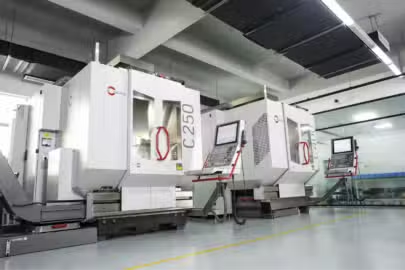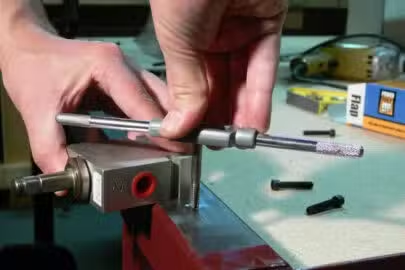Digital manufacturing, a transformative influence in modern industry, has redefined the landscape of CNC and rapid prototyping services. In the era of Industry 4.0, the convergence of advanced technologies is not only optimizing efficiency but also transforming traditional manufacturing processes. This article delves into the nuances of digital manufacturing, examining its key technologies, applications, and the profound impact it has on businesses embracing the future of production.
What is Digital Manufacturing?

Digital manufacturing entails the use of a computer-based system that includes simulation, 3D visualization, analytics, and collaborative tools. This method allows for the creation of product and manufacturing process definitions at the same time. Design for manufacturability (DFM), computer-integrated manufacturing (CIM), flexible manufacturing, and lean manufacturing are all driving forces in the advancement of digital manufacturing. These initiatives highlight the relevance of collaborative product and process design in changing the digital manufacturing landscape.
Modeling and simulating processes have the potential to improve the quality of manufacturing decision-making. This not only optimizes operations, resulting in cost savings and reduced time to market, but it also provides a unified manufacturing procedure that seamlessly connects digital tools with physical production execution.
Using a computer-centric process allows manufacturers to develop a digital thread across the manufacturing journey, simplifying data analysis across the product lifetime and the construction of actionable procedures. Furthermore, digital manufacturing technologies simplify the transmission of client data to product managers. This aids in forecasting demand and managing continuing maintenance requirements, providing a client-centered approach to production that caters to the individual needs of the clients.
Evolution of Digital Manufacturing
Digital manufacturing can be traced back to the late twentieth century when the first computer-aided design (CAD) software was introduced. This ground-breaking program enabled engineers and designers to create 3D models of objects, paving the way for the creation of their counterparts.
Digital manufacturing’s evolution has been tremendously transformational, altering design and manufacturing processes across a wide range of products. It has evolved into a sophisticated system over time.
Digital manufacturing has invaded practically every industry in the modern period, including aerospace, automotive, medical, and consumer items. It is the core of modern manufacturing, allowing businesses to speed up the design and production of products while increasing cost-effectiveness and precision. Furthermore, it is critical in reducing waste and optimizing production yields, reinforcing its position as a vital tool for modern firms.
Key Technologies in Digital Manufacturing

A digital factory’s networked capabilities provide producers with numerous prospects for achieving scalable agility, flexibility, and operational efficiency. It is critical to recognize that technological improvements go beyond simply replacing traditional labor with robots. These digital solutions are critical for bridging the gap between separate processes and giving quick transparency in operation at a glimpse.
- Additive Manufacturing (3D Manufacturing)
The cornerstone of digital manufacturing, additive manufacturing, commonly known as 3D printing, has emerged as a game-changer in CNC and rapid prototyping services. It allows for the specialized manufacturing of distinct or customized goods and components in factory settings. When combined with predictive maintenance plans, additive manufacturing can generate substitute parts in a single print far before the need for replacement or repair becomes a major concern.
Notably, prominent providers such as Nike are using this technology to connect clients to the production line by giving web tools for customizing shoe designs that are then 3D printed. These applications are simply a taste of the broader effects of 3D printing for the entire process of production, which allows for the printing of single things rather than assembly from diverse parts. From prototyping to end-use production, 3D printing enables unparalleled flexibility and customization, reducing lead times and material wastage.
- Subtractive manufacturing (CNC Machining Advancements)
While CNC machining has long been a stalwart in precision manufacturing, recent advancements have propelled it into the digital age. Integration with computer-aided design (CAD) and computer-aided manufacturing (CAM) systems has streamlined the entire process, enhancing precision and repeatability. CNC machines, or computer numerical control machines, then take charge of the production phase.
Real-time monitoring and feedback mechanisms ensure adaptive machining, where adjustments can be made on the fly, optimizing production outcomes. Water jets, lathes, and mills use produced code to move components and tools between axes, including or excluding material. The ultimate output exactly mimics its digital counterpart, and wireless networking of CNC machines with CAD systems considerably increases interaction between developers and floor operators.
- Automation and robotics
If you have ever wondered about the role of robots in manufacturing, they are artificial beings meant to do jobs that eliminate the need for human labor. Their presence, however, is extremely advantageous to the industrial business, especially in areas such as maintenance and quality control. Robotics advancements have paved the door for the automation of more complex jobs. Modern examples include robotic arms that can be operated in 3D space by a human operator to reproduce precise actions.
The machine may then automate those motions while also evaluating and optimizing its performance. Similarly, autonomous robot cars help to improve warehouse productivity by quickly analyzing tasks and finding the most efficient way to fetch products, even when numerous orders are involved.
Integration of Digital Twins
A digital twin is a virtual version of a physical product, process, service, or environment that duplicates its real-world counterpart’s behavior and appearance.
It can be a computer reproduction of a physical thing such as a jet engine, wind farms, buildings, or even towns. On the other hand, digital twin technology is used to reproduce processes or run simulations to collect data and forecast how these processes will function.
A digital twin is a computer program that uses real-world data to develop simulations that anticipate the results of a product or process. This simulation takes into account both the asset’s current state and previous data. To improve their output, these programs can use the Internet of Things (IoT), artificial intelligence, and software analytics. The use of IoT sensors promotes the transfer of real-world data, resulting in virtual representations in the digital domain.
Machine learning advancements and the influence of elements such as big data have raised virtual models to a cornerstone in modern engineering, spurring innovation and improving performance.
In a nutshell, constructing these virtual models allows for the amplification of important technology trends, works as a buffer against costly failures in physical items, and tests processes and services using enhanced analytical, monitoring, and predictive capabilities.
Benefits of Digital Twins for CNC and Rapid Prototyping
In the field of rapid prototyping, virtual commissioning emerges as a crucial advantage of digital twins. It refers to the ability to test system, machine, or factory updates and changes before applying them in the physical environment. This eliminates time-consuming trial-and-error methods and significantly reduces downtime. The use of virtual commissioning in conjunction with digital twins allows for a more precise simulation of conditions. Developers guarantee that any upgrades or alterations are thoroughly tested before being pushed into production by creating a perfect replica of the original system.
The digital twin simulates the exact conditions of the environment faced by the physical prototype, which leads to fewer risks and delays due to unanticipated complications. Consider someone who wants to modernize a robotic manufacturing facility. They can test the new software update on their digital counterpart before actually implementing it using virtual commissioning. This proactive strategy allows for the early identification of potential difficulties, saving not just time and money but also reducing potential frustrations caused by unanticipated issues during physical commissioning.
Industry 4.0 and Smart Manufacturing
Industry 4.0 is the concrete expression of the field’s ongoing digital transformation in the world of smart manufacturing. This progress results in real-time decision-making, increased productivity, and more flexibility and agility.
The shift brought about by Industry 4.0 is transforming firms’ manufacturing, improvement, and distribution processes. Manufacturers are integrating cutting-edge technology such as the Internet of Things (IoT), cloud computing, analytics, and AI and machine learning into their manufacturing facilities and processes.
These intelligent factories use advanced sensors, embedded software, and robotics to facilitate data collecting and analysis for informed decision-making. The integration of data from manufacturing processes with information from ERP, supply chain, customer support, and other corporate systems adds substantial value, enabling unprecedented levels of awareness and understanding by breaking down formerly segregated information silos.
Adoption of digital technologies leads to increased automation, predictive maintenance, self-optimization of process improvements, and, most crucially, hitherto unattainable levels of efficiency and responsiveness to customers.
The construction of smart factories represents an extraordinary potential for the manufacturing industry to actively participate in the fourth industrial revolution. Real-time visibility of production assets is ensured by analyzing large amounts of big data collected from sensors on the factory floor. Furthermore, this data serves as a platform for creating predictive maintenance procedures to reduce equipment downtime.
The use of powerful IoT devices in smart factories increases productivity and quality. Substituting AI-powered visual insights for manual inspection procedures not only decreases manufacturing errors but also saves money and time. Quality control staff can establish a smartphone connected to the cloud for monitoring industrial operations from nearly any location for a small cost. Manufacturers may detect mistakes promptly by utilizing machine learning algorithms, avoiding costly repair work in the future.
Industry 4.0 principles and technologies are applicable across a wide range of industrial sectors, including discrete and process manufacturing, as well as industries such as oil and gas, mining, and others.
Challenges of Digital Manufacturing
Despite its numerous advantages, digital manufacturing also presents some potential challenges that Include:
- Availability of skilled personnel
One of the most noteworthy issues in digital manufacturing is the scarcity of competent labor. The requirements for digital manufacturing exceed those of traditional techniques, necessitating a greater level of technical expertise and knowledge that can be difficult to find. Qualified labor is generally in short supply, and organizations migrating to digital manufacturing may need to invest in training or acquire additional qualified individuals.
The dynamic and ever-changing character of the digital manufacturing process emphasizes the importance of ongoing training and education for professional personnel. This continual need for learning is a difficulty because it is not always easy to locate and retain individuals with the necessary abilities and expertise.
- Cybersecurity concerns
Data security issues have emerged as a serious challenge in digital manufacturing. The increased interconnectedness of industrial systems increases the vulnerability to cyber-attacks. Malicious intrusions such as malware, ransomware, and phishing pose a risk to businesses, resulting in hazards such as data loss, service outages, and intellectual property theft.
Maintaining vigilance against potential data breaches caused by human mistakes, such as unauthorized access or weak passwords, is critical. To safeguard systems and data, businesses must take a multidimensional strategy that incorporates a variety of tactics and approaches, including white box pen-testing. Encryption implementation, access control enforcement, and frequent security upgrades are critical measures in strengthening these security challenges.
- Cost of Initial Upfront-Investment
When compared to their larger competitors, small and medium-sized enterprises frequently face financial restraints. The big initial investments provide enormous challenges that they frequently cannot afford to overcome.
However, the consequences of non-adoption are equally enormous and cannot be ignored. Failure to keep up with the competition and falling short of market expectations are significant hazards that businesses want to avoid.
To overcome this conundrum, businesses must develop an execution strategy and investment plans based on correct insights and predictions. This technique becomes critical in striking a compromise between budgetary constraints and the critical necessity to remain competitive and meet market expectations.
Future of Digital Manufacturing

As the use of information for manufacturing processes becomes more automated, the trajectory of digital manufacturing appears to be set for continuing growth in the future.
Industrial Digital Technologies (IDT) will continue to play an important role in the manufacturing industry. Standard technologies like the Internet of Things, Robotics, and Artificial Intelligence enable the manufacturing industry to realize its digital manufacturing goal. While there may be concerns about potential job losses, studies show a boom in specialist skills needed for the application of these digital manufacturing systems.
Despite the rapid acceptance of digital technologies by many businesses, there are still some that are lagging in adopting these innovations.
Individual technologies have been effortlessly integrated into cohesive systems as part of Industry 4.0, centralizing and connecting the manufacturing system. This integration has successfully used new technology advances to meet global concerns brought about by digitalization and virtual technologies. Real-time data exchange and flexible manufacturing have been significant drivers, allowing for customized production to meet changing demand.
The continued growth of Industry 4.0, which is defined by systems capable of seamless interaction, suggests a consistent trend toward integrated manufacturing. Through increasing connectivity and collaboration, this trajectory attempts to boost competitiveness and streamline operations.
Digital manufacturing technology can transform numerous aspects of manufacturing, transforming them into interconnected value chains. This includes everything from supply chain logistics algorithms to detailed visualization of product design, digital marketing, quality control, and several other industrial issues.
In essence, the combined and integrated utilization, together with the potential for real-time applications, broadens the opportunity for future uses. However, the advent of new technologies, as well as their combination, integration, refinement, and joint use, provides new difficulties and opportunities. These technologies have the potential to affect operational and organizational strategies, thus altering the future landscape of the industrial sector.
Conclusion
The creation of digital manufacturing capabilities necessitates a thorough examination of the existing components and characteristics that contribute to the success of a production line. The efficiency of the manufacturing process has been improved, allowing for greater product personalization. The positive influence of digital manufacturing ripples throughout the industry, supporting increased efficiency and agility. This technology breakthrough not only opens up new potential for producers, but also improves the customer experience by allowing them to buy things more quickly. Businesses should expect greater efficiency gains as digital manufacturing technology evolves.
One of the reputable manufacturing companies that have incorporated digital manufacturing into their processes is Zintilon. At Zintilon, our wealth of experience in manufacturing a wide array of projects across diverse industries is dedicated to providing optimal value and superior quality to our partners. We provide a comprehensive range of manufacturing services, ranging from rapid prototyping to low-volume and mass parts production. Central to our manufacturing service is specialized capacity, with a particular focus on CNC machining, sheet metal fabrication, and die casting. Visit us today to explore more about the services we can render.
FAQs
What is digital manufacturing?
Digital manufacturing involves the use of software and computer systems to control and improve the manufacturing process. This encompasses a range of technologies, including but not limited to 3D printing, Computer-Aided Design (CAD), Computer-Aided Manufacturing (CAM), Computer Numerical Control (CNC), and robotics.
What is Industry 4.0?
Industry 4.0 signifies the fourth industrial revolution, extending its scope beyond traditional industry applications to include areas not typically classified as such, such as smart cities.
What are the benefits of digital manufacturing?
Digital manufacturing offers a range of benefits, including improved efficiency, accelerated decision-making, increased equipment uptime, enhanced supply chain management, error reduction, quicker turnaround times, and reduced costs.




